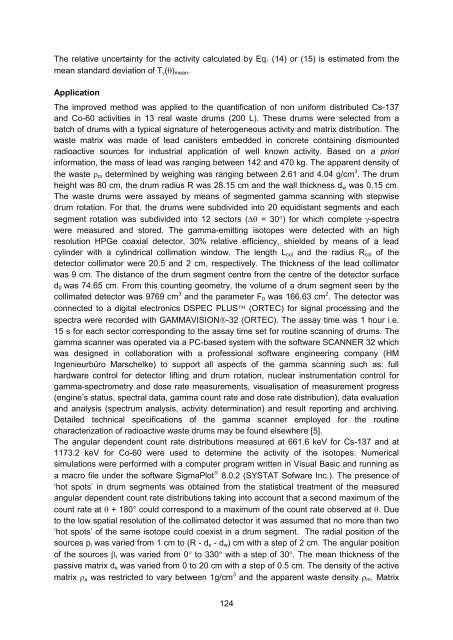Annual Report 2009/2010 - JUWEL - Forschungszentrum Jülich
Annual Report 2009/2010 - JUWEL - Forschungszentrum Jülich
Annual Report 2009/2010 - JUWEL - Forschungszentrum Jülich
You also want an ePaper? Increase the reach of your titles
YUMPU automatically turns print PDFs into web optimized ePapers that Google loves.
The relative uncertainty for the activity calculated by Eq. (14) or (15) is estimated from the<br />
mean standard deviation of T () mean .<br />
Application<br />
The improved method was applied to the quantification of non uniform distributed Cs-137<br />
and Co-60 activities in 13 real waste drums (200 L). These drums were selected from a<br />
batch of drums with a typical signature of heterogeneous activity and matrix distribution. The<br />
waste matrix was made of lead canisters embedded in concrete containing dismounted<br />
radioactive sources for industrial application of well known activity. Based on a priori<br />
information, the mass of lead was ranging between 142 and 470 kg. The apparent density of<br />
the waste m determined by weighing was ranging between 2.61 and 4.04 g/cm 3 . The drum<br />
height was 80 cm, the drum radius R was 28.15 cm and the wall thickness d w was 0.15 cm.<br />
The waste drums were assayed by means of segmented gamma scanning with stepwise<br />
drum rotation. For that, the drums were subdivided into 20 equidistant segments and each<br />
segment rotation was subdivided into 12 sectors ( ) for which complete -spectra<br />
were measured and stored. The gamma-emitting isotopes were detected with an high<br />
resolution HPGe coaxial detector, 30% relative efficiency, shielded by means of a lead<br />
cylinder with a cylindrical collimation window. The length L col and the radius R col of the<br />
detector collimator were 20.5 and 2 cm, respectively. The thickness of the lead collimator<br />
was 9 cm. The distance of the drum segment centre from the centre of the detector surface<br />
d 0 was 74.65 cm. From this counting geometry, the volume of a drum segment seen by the<br />
collimated detector was 9769 cm 3 and the parameter F 0 was 166.63 cm 2 . The detector was<br />
connected to a digital electronics DSPEC PLUS (ORTEC) for signal processing and the<br />
spectra were recorded with GAMMAVISION-32 (ORTEC). The assay time was 1 hour i.e.<br />
15 s for each sector corresponding to the assay time set for routine scanning of drums. The<br />
gamma scanner was operated via a PC-based system with the software SCANNER 32 which<br />
was designed in collaboration with a professional software engineering company (HM<br />
Ingenieurbüro Marschelke) to support all aspects of the gamma scanning such as: full<br />
hardware control for detector lifting and drum rotation, nuclear instrumentation control for<br />
gamma-spectrometry and dose rate measurements, visualisation of measurement progress<br />
(engine’s status, spectral data, gamma count rate and dose rate distribution), data evaluation<br />
and analysis (spectrum analysis, activity determination) and result reporting and archiving.<br />
Detailed technical specifications of the gamma scanner employed for the routine<br />
characterization of radioactive waste drums may be found elsewhere [5].<br />
The angular dependent count rate distributions measured at 661.6 keV for Cs-137 and at<br />
1173.2 keV for Co-60 were used to determine the activity of the isotopes. Numerical<br />
simulations were performed with a computer program written in Visual Basic and running as<br />
a macro file under the software SigmaPlot 8.0.2 (SYSTAT Sofware Inc.). The presence of<br />
‘hot spots’ in drum segments was obtained from the statistical treatment of the measured<br />
angular dependent count rate distributions taking into account that a second maximum of the<br />
count rate at + 180° could correspond to a maximum of the count rate observed at . Due<br />
to the low spatial resolution of the collimated detector it was assumed that no more than two<br />
‘hot spots’ of the same isotope could coexist in a drum segment. The radial position of the<br />
sources p i was varied from 1 cm to (R - d s - d w ) cm with a step of 2 cm. The angular position<br />
of the sources i was varied from 0 to 330 with a step of 30. The mean thickness of the<br />
passive matrix d s was varied from 0 to 20 cm with a step of 0.5 cm. The density of the active<br />
matrix a was restricted to vary between 1g/cm 3 and the apparent waste density m . Matrix<br />
124
















